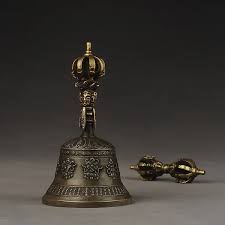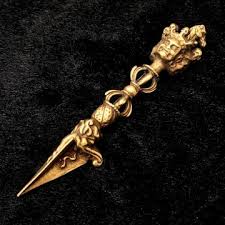Vajra:
In ancient India, Indra, one of his magical weapons, we now call him Vajra, but in Sanskrit, it means thunderbolt, which is like thunder and lightning and can destroy things. This is an analogy in Buddhism. Diamond is actually the hardest diamond. When we make a diamond, it has ten degrees of hardness, so it can destroy other substances, but other substances cannot cut it. It is used to describe the wisdom of Buddhas and Bodhisattvas, which is like a diamond. So when we talk about the Diamond Sutra, we are talking about the wisdom of Prajna. Therefore, it means that wisdom can destroy troubles, but troubles cannot shake wisdom. Therefore, when practicing the Dharma, using this expression to practice this Dharma can help everyone generate wisdom and not be affected by troubles. Therefore, vajra is used in general pujas. Because the pestle, we say it is wisdom and represents the "intention" of the Buddhas. If the Buddhas are divided into different characteristics of body, speech and mind, the mind of the Buddhas is wisdom.
Diamond Bell:
The Vajra is basically not used alone. The five-branched Vajra can represent the five Buddhas. Each of the five Buddhas has different wisdom characteristics, so it is called the Five Buddhas and Five Wisdoms. This is symbolic. The bells and pestles are used in pairs, and the bells represent the "words" of the Buddhas. When the bells are ringed, they make sounds, which symbolize the words of the Buddhas. When we use the magical instruments, we need to understand how the sound is produced? There will be no sound if the bell is left standing, and there will be no sound if the tongue in the middle is removed. This means that all dharmas, including Buddhist dharma, can only be produced by the combination of causes and conditions. It will have a dependent origin, so it is like this In other words, it is the wisdom mentioned in Buddhism, which refers to the wisdom of emptiness. Dependent origination is empty. This is the so-called integration of wisdom and convenience. Many people may think that what "convenience" is, in fact, convenience is a method. You have wisdom, but how to realize it requires you to have some skills, so it is called "skillful and convenient".

Use such a magic weapon to remind us not to forget the wisdom we originally possess. But after doing it for a long time, you can understand it according to your different levels of practice.
In general rituals, when ringing the bell, it can be used to praise the Buddhas or to welcome the Buddhas to come, just like when important state guests come here, there will be cannons or military bands outside. It has the meaning of praise.

Tambourine:
There are usually certain uses in rituals. The vajra bell and pestle are often used in pairs. Usually, a tambourine (small) is also added. The tambourine is paired with the vajra bell. It is what we call welcoming distinguished guests or arranging a ride. a ritual at that time. It is equivalent to performing it in the way of serving the Buddha with sound.
Another (bigger) tambourine is used in the body giving method. Through the wisdom of Prajna, the body is given away through visualization. It has no eyes, ears, nose, tongue, body and mind, no color, body, fragrance, touch, and chanting while shaking the drum. At the same time, visualize.
Padma Khyentse Rinpoche
|